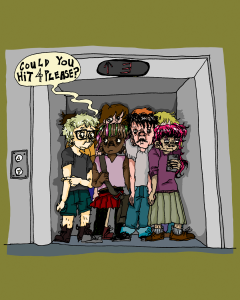OPINION: Regulate e-cigarettes like traditional cigarettes
October 10, 2019
Rumors of banning flavored vape juices circulated the last few years, but in recent months, more states and cities have imposed their own bans. In addition, the Trump administration announced it would ban most flavored e-cigarettes Sept. 11.
Yet, a lot of this blame is misplaced. The media reported 1000 illnesses related to vaping, but many of the illnesses can be blamed on fake THC vapes. While the traditional e-cigarette most commonly associated with traditional cigarettes contains only nicotine, there has been a recent wave of counterfeit THC vapes that have put a number of people in the hospital. A recent analysis of 578 patients suffering from lung injuries related to vaping found that 78% of the patients used THC vaporizers, compared to 17% who used only nicotine.
It’s common to see students vaping on campus. Teen smoking rates have fallen over 25% in the last 25 years, but vaping has quickly filled the gap left by traditional cigarettes.
Every time a young person vapes, the question of whether they’re using e-cigarettes to stop smoking cigarettes or for recreational purposes lingers. If they are vaping recreationally, would they have started if there were not enticing flavors? Eighty-one percent of youth e-cigarette users cited the fruity flavors as a main draw for their use, according to the Food and Drug Administration.
I remember when my parents stopped smoking. Every day after dinner, they would hunker down with their nicotine gum and blast through three episodes of the TV show “24,” using Kiefer Sutherland fighting terrorists to keep them from going outside to smoke. While their will and the nicotine gum worked; for some, it does not. Using e-cigarettes is an invaluable tool for some to quit smoking; for many, it’s the only way to stop.
E-cigarettes are hailed by many as a safer alternative to smoking — one of the many arguments being e-cigarettes contain less harmful chemicals than traditional cigarettes.
In 2009, Congress passed the Family Smoking Prevention and Tobacco Control Act. The act gave the FDA the power to regulate the manufacturing, distributing and advertising of all tobacco products. Among other measures, the FDA banned the sale of all traditional cigarette flavors except for tobacco and menthol.
Since the act passed, there has not been a total ban on cigarettes. People who want to smoke them still smoke them.
The same ban on flavors needs to be done with e-cigarettes. By eliminating the allure of fun flavors, the appeal is taken away from those who started using e-cigarettes for fun, not to quit smoking. But, it still leaves an option for adults who want to stop smoking.
This has already been implemented, to some degree. In November, Juul Labs Inc., one of the most popular e-cigarette brands, announced it would stop selling flavored pods in stores and suspend social media advertisements.
There is no denying the positives of vaping; it helps those who smoke traditional cigarettes switch to a less harmful alternative and, ultimately, quit. The issue is that regulators and companies need to treat e-cigarettes more like the products they emulate and hold them to the same standards. That means, hold companies to the same flavor standards and uphold the same restrictions on advertising and manufacturing of e-cigarettes, because regulations cannot ruin e-cigarettes for people who need them to quit smoking traditional cigarettes.













charlie • Oct 11, 2019 at 1:17 pm
Your vew of flavors in ecigs does not account for the role they play. Back in the day I quit cold turkey and relapsed after 10 YEARS! This won’t happen again. Today my palate is conditioned to vaping which has the effect of making cigarettes taste awful. Otherwise that first fall-off-the-wagon puff would be entirely too pleasurable.
Nicotine is not as addictive as claimed, otherwise the FDA would have allowed nicotine gum and patches be allowed for sale over the counter without a perscription. In my experience nicotine alone is about 80% less habit forming than tobacco cigarettes.
Kids are not attracted to flavor or nicotine, obviously since they have experienced neither. What attracts them is the visible vapor. I can take a puff literally anywhere and upset no one so long as there is no visible vapor.
If I had a teenager at home I’d say, kid, if you’re curious about vaping come to me and I’ll hook you up. I would get a low power device set to about age = watts and make some 0 nic mildly flavored liquid and say, here ya go but can’t take it out of the house. He would tire of blowin smoke rings after a few days. I wish ecigs were around when I was a kid.
Most of the people shooting off their mouths about vaping haven’t done their homework, they don’t know squat.
Thanks for writing a somewhat fair article.